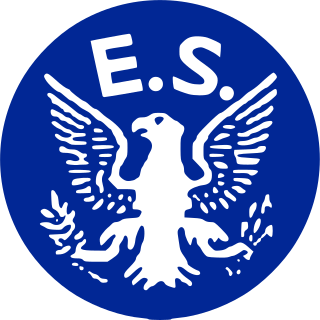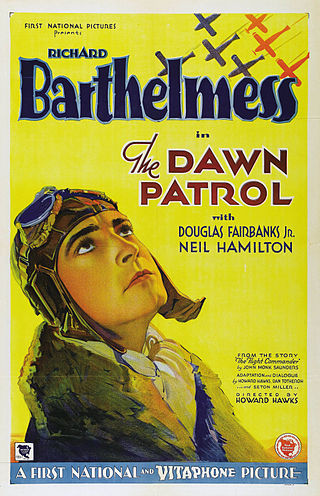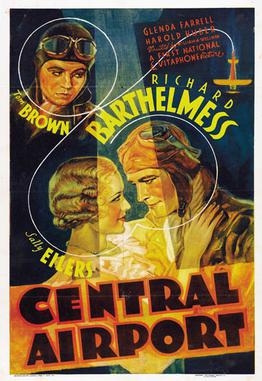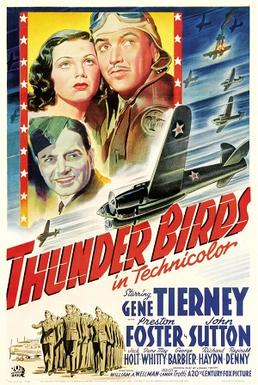
Darryl Francis Zanuck was an American film producer and studio executive; he earlier contributed stories for films starting in the silent era. He played a major part in the Hollywood studio system as one of its longest survivors. He produced three films that won the Academy Award for Best Picture during his tenure at 20th Century Fox.

The Eagle Squadrons were three fighter squadrons of the Royal Air Force (RAF) formed with volunteer pilots from the United States during the early days of World War II (1940), prior to America's entry into the war in December 1941.

The Dawn Patrol is a 1930 American pre-Code World War I film starring Richard Barthelmess and Douglas Fairbanks Jr. It was directed by Howard Hawks, a former World War I flight instructor, who even flew in the film as a German pilot in an uncredited role. The Dawn Patrol won the Academy Award for Best Story for John Monk Saunders, an American writer said to have been haunted by his inability to get into combat as a flyer with the U.S. Air Service. It was subsequently remade in 1938 with the same title, and the original was then renamed Flight Commander and released later as part of the Warner Bros. film catalog.

133 Squadron RAF was one of the famous Eagle Squadrons formed from American volunteers serving with the Royal Air Force (RAF) during the Second World War.

A Yank in the R.A.F. is a 1941 American black-and-white war film directed by Henry King and starring Tyrone Power and Betty Grable. Released three months before the attack on Pearl Harbor plunged the United States into World War II, it is considered a typical early-World War II production. Originally titled The Eagle Squadron, it is based on a story by "Melville Crossman", the pen name for 20th Century Fox studio chief Darryl F. Zanuck. It follows an American pilot who joins the Royal Air Force (RAF), during a period when the United States was still neutral.

The Court-Martial of Billy Mitchell is a 1955 American CinemaScope biographical drama film directed by Otto Preminger, and starring Gary Cooper and co-starring Charles Bickford, Ralph Bellamy, Rod Steiger, and Elizabeth Montgomery in her film debut. The film is based on the 1925 court-martial of General Billy Mitchell, who is considered a founding figure of the U.S. Air Force.

Air Force is a 1943 American World War II aviation film directed by Howard Hawks and starring John Garfield, John Ridgely, Gig Young, Arthur Kennedy, and Harry Carey. The film was distributed by Warner Bros. and produced by Hal B. Wallis and Jack L. Warner. Conceived by then - Lieutenant General “Hap” Arnold in the aftermath of the Pearl Harbor attack, it was originally scheduled for release on December 7, 1942, on the first anniversary. It became impossible to meet that deadline, and it premiered in New York City on February 3, 1943 and was released on March 20. The film's storyline revolves around an actual event that occurred on December 7, 1941. An aircrew ferries an unarmed 1940 series Boeing B-17D Flying Fortress heavy bomber, named the Mary-Ann, across the Pacific to the United States Army Air Forces base at Hickam Field. They fly right into the middle of the Japanese air attack on Pearl Harbor and the beginning of America's major involvement in the Second World War. An uncredited William Faulkner wrote the emotional deathbed scene for Ridgely, who played the commander and pilot of the Mary-Ann.

Flying Tigers is a 1942 American black-and-white war film drama from Republic Pictures that was produced by Edmund Grainger, directed by David Miller, and stars John Wayne, John Carroll, and Anna Lee.

Fighter Squadron is a 1948 American World War II aviation war film in Technicolor from Warner Bros., produced by Seton I. Miller, directed by Raoul Walsh, that stars Edmond O'Brien, Robert Stack, and John Rodney.

Desperate Journey is a 1942 American World War II action and aviation film directed by Raoul Walsh and starring Errol Flynn and Ronald Reagan. The supporting cast includes Raymond Massey, Alan Hale Sr., and Arthur Kennedy. The melodramatic film featured a group of downed Allied airmen making their way out of the Third Reich, often with their fists.

Central Airport is a 1933 American pre-Code aviation drama film directed by William A. Wellman, based on the John C. "Jack" Moffitt story, "Hawk's Mate". The film stars Richard Barthelmess and Sally Eilers. Central Airport was produced and released by Warner Bros., on April 15, 1933. John Wayne had an uncredited part in the film, playing a co-pilot, and this film features his first on-screen death.

William Paul Lundigan was an American film actor. His more than 125 films include Dodge City (1939), The Fighting 69th (1940), The Sea Hawk (1940), Santa Fe Trail (1940), Dishonored Lady (1947), Pinky (1949), Love Nest (1951) with Marilyn Monroe, The House on Telegraph Hill (1951), I'd Climb the Highest Mountain (1951) and Inferno (1953).

Thunder Birds is a 1942 Technicolor film directed by William A. Wellman and starring Gene Tierney, Preston Foster, and John Sutton. It features aerial photography and location filming at an actual Arizona training base of the United States Army Air Forces named Thunderbird Field No. 1 during World War II.

Dive Bomber is a 1941 American aviation drama film directed by Michael Curtiz, and starring Errol Flynn, Fred MacMurray and Alexis Smith. It was produced and distributed by Warner Brothers. The film is notable for both its Technicolor photography of pre-World War II United States Navy aircraft and as a historical document of the U.S. in 1941. This includes the aircraft carrier USS Enterprise, one of the best-known U.S. warships of World War II.

Antoinette Olympe Bradna was a French dancer and actress, who emigrated to the United States where she lived for the rest of her life.

The Thousand Plane Raid is a 1969 DeLuxe Color film directed by Boris Sagal and starring Christopher George and Laraine Stephens. Although claimed to be derived from Ralph Barker's The Thousand Plane Raid, the storyline of the film inaccurately portrays the first raid as an 8th Air Force mission while the actual attack was undertaken by 1,047 Royal Air Force bombers against the city of Cologne, Germany in May 1942.

Eagle Squadron is a 1942 American war film directed by Arthur Lubin and starring Robert Stack, Diana Barrymore, John Loder and Nigel Bruce. It was based on a story by C.S. Forester that appeared in Cosmopolitan magazine, and inspired by media reports of the fighting in the Battle of Britain, in particular, the American pilots who volunteered before the United States entered World War II, to fly for the Royal Air Force in the actual Eagle Squadrons.

Flying Fortress is a 1942 British black-and-white war film drama from Warner Bros. Pictures, produced by A. H. Soloman, directed by Walter Forde, that stars Richard Greene and co-stars Carla Lehmann, Betty Stockfeld, and Donald Stewart.

Knockout is a 1941 American sports drama film directed by William Clemens and written by M. Coates Webster. The film stars Arthur Kennedy, Olympe Bradna, Virginia Field, Anthony Quinn, Cliff Edwards and Cornel Wilde. The film was released by Warner Bros. on March 29, 1941.

Frank Clarke was a Hollywood stunt pilot, actor, and military officer. His most prominent role was as Leutnant von Bruen in the 1930 production Hell's Angels, but he flew for the camera and performed stunts in more than a dozen films in the 1930s and 1940s. Clarke was killed in an aircraft crash near Isabella, California, in 1948.




















